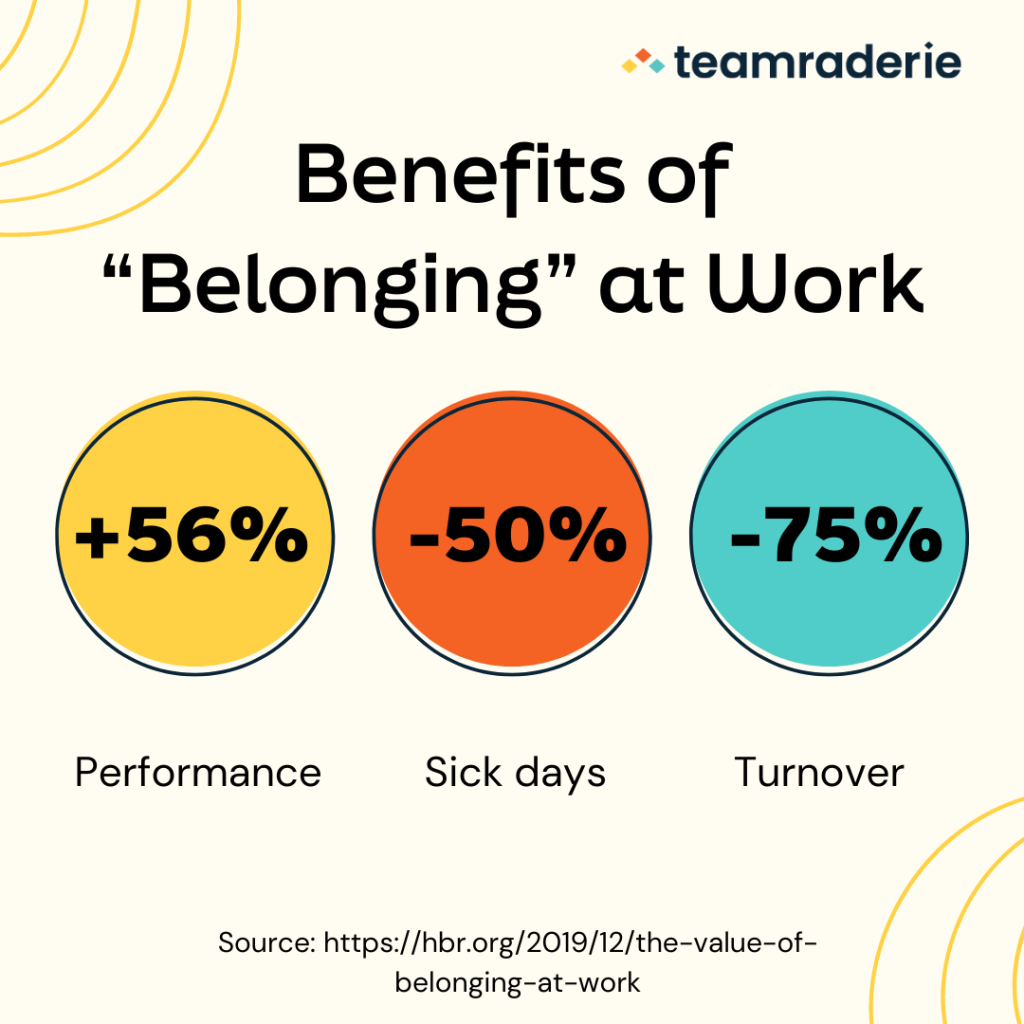Have you ever wondered how to create a sense of belonging for your team?
When employees feel a strong sense of belonging, their well-being, engagement, and performance are all likely to improve. Research from Harvard Business Review (HBR) shows that this creates many bottom-line benefits for a company.
In hybrid workplaces, which are increasingly common, experiencing workplace culture has become more elusive. However, this doesn’t have to be the case.
Here’s an overview of the importance of belonging and three tips for creating a sense of belonging in your workplace.
The Importance of Belonging
In the United States, 40% of employees feel isolated at work. This problem can be exacerbated by remote work since socialization is often more difficult.
A sense of belonging is vital to overcoming this isolation. Especially in hybrid and remote environments, employees who feel that they belong are more likely to feel connected to their team.
Creating a sense of belonging in the workplace reinforces three essential attributes:
- Comfort: Feeling respected and treated fairly by team members and leaders.
- Contribution: Being a part of positive outcomes and knowing how one’s strengths contribute to those goals.
- Connection: Having meaningful relationships with others and a connection to the company’s goals.
Not only does belonging impact employee well-being, it also benefits the organization as a whole.
HBR research demonstrates the value of belonging to a company’s bottom line:
- 56% improved team performance
- 50% fewer sick days
- 75% lower turnover rates

But what steps can leaders take to foster a sense of belonging in their team? Below are three tips.
3 Ways To Create a Sense of Belonging in Your Team
In an article from HBR, practitioners from Spotify and ManpowerGroup identified three challenges that leaders must navigate to foster belonging and help their teams stay connected:
- Creating a strong culture with effective DIB (diversity-inclusion-belonging) practices
- Retaining the social element of work, even when people work remotely
- Having the courage to let the culture evolve
Figure out how to create a sense of belonging and community within organizations where fear, anger, and depression during the pandemic are being replaced by choice, flexibility, and freedom.
Clinging to the old ways of working can harm team culture and performance.
Here’s a deeper dive into overcoming these challenges to create belonging:
1. Hire For Culture “Add-On”
Many companies hire for culture fit. However, to promote belonging, it’s a good idea to take this concept a step further by considering hiring based on who adds something to the culture.
You want to bring in people that work well with the current culture but add something that isn’t already there. This is the best method to ensure culture remains strong but you also have diversity and inclusion practices at work.
Research from Gallup reveals that when companies perceive new ways of thinking or divergent opinions as “countercultural,” the culture is much more likely to fail.
A culture that promotes diversity and inclusion can go a long way in creating a strong sense of belonging. It can also prevent drawbacks like groupthink and stagnation.
2. Retain the Social Element of Work
With more and more businesses operating on a hybrid or remote basis, it can seem challenging to keep the social element alive. Leaders need to be willing to create opportunities for employees to meaningfully engage with each other.
While focusing on how to create a sense of belonging, consider how you can bring people together.
For instance, perhaps the team could participate in a virtual charity event or you could start a gratitude event with e-notes of thanks to colleagues. Consider implementing an employee resource group that brings people together in their shared interests.
Here are some other methods to create remote socialization opportunities:
- Come up with creative ways to celebrate holidays and birthdays.
- Provide room for workers to chat informally about things other than work.
- Add space to meetings for everyone to chat at the end.
Even if your team is in-person, it’s crucial to find ways to prioritize socialization.
Research shows that social activities are one of the top benefits employees list of in-office work. If employees aren’t afforded these opportunities, they’ll be missing out on the top benefit of in-person working arrangements.
Whether your team is remote or in-person, Teamraderie’s live, virtual experiences are perfect for facilitating these kinds of activities.
3. Let the Culture Evolve
It might seem frightening to let the culture evolve at a workplace if it’s been the same for an extended period. However, it’s important to reframe culture changes as positives and opportunities to grow as a company.
Consider the fact that every crisis impacts the world and changes it. Even if a system worked through a crisis, that doesn’t mean change might not be useful.
As you ponder how to create a sense of belonging, think about what changes are needed. Give yourself time to see the benefits before deciding you shouldn’t move forward. Sometimes the best thing you can do is move forward and try new things.
Leveraging Teamraderie to Create Belonging
If you’re still searching for how to create a sense of belonging in your workplace, let employees provide you with feedback and the answers you’re seeking. After all, they’re the ones who know precisely what they need.
Speak to them directly and open conversations about how things can be improved. Brainstorm ideas and consider what will work best to build a workplace where everyone belongs.
Teamraderie’s experiences are great for creating connection and belonging in the workplace. Approximately 90% of teams that leverage our expert-led team experiences experience experience increased connection as a result.
Click here to browse our 60+ team experiences to find the perfect experience for your team.




